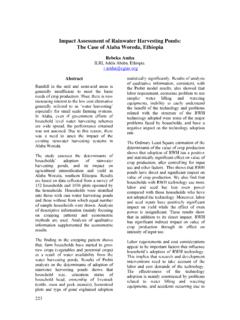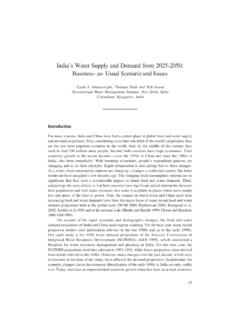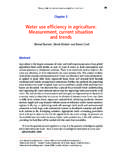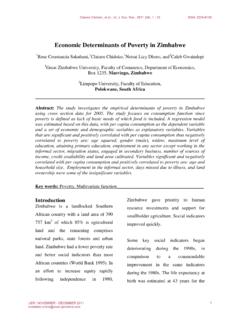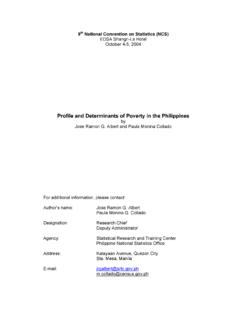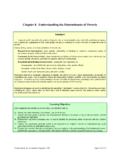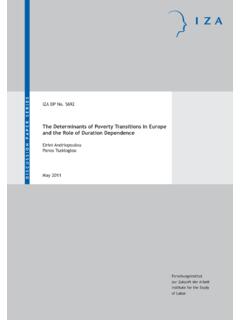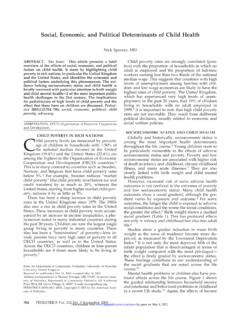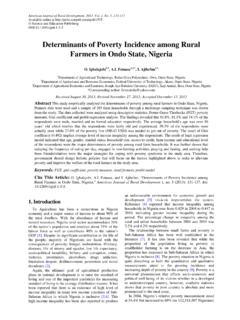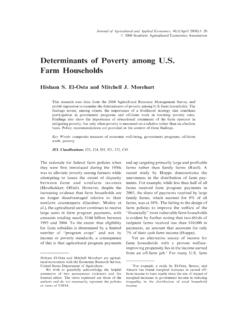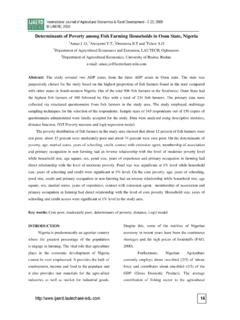Transcription of DETERMINANTS OF POVERTY - HQDOCS Report
1 101 DETERMINANTS OF POVERTY Khalid Mahmood Khan1 Understanding the Nature of Locus of POVERTY For strategy formulation, it is important to understand who the poor are, where they live, and what is their source of livelihoods. POVERTY is multi-dimensional and extends from low levels of income and consumption to poor health and lack of education to other non-material dimensions of well being, including gender disparities, insecurity, powerlessness and social exclusion. A good understanding of the nature of POVERTY enables a comprehensive exploration of POVERTY DETERMINANTS .
2 POVERTY reduction is the most urgent task facing humanity. The estimates for the world show that about one-third or more than billion people in developing world still struggle to survive on less than one dollar a day. The World Bank (2002) reported that 31 percent of the population was living below one dollar a day during 1997 in Pakistan. ActionAid - an NGO, reported the same estimates. Moreover, 67 percent of women and 43 percent of men are illiterate, and only 42 percent of rural population has access to adequate sanitation in Pakistan. What Causes POVERTY ?
3 The DETERMINANTS of POVERTY could be macro, sector-specific, community, household and individual characteristics. The paper highlights some of the characteristics of the poor by region, community, household and individual characteristics followed by quantitative and qualitative description of the major DETERMINANTS of POVERTY . These characteristics can be used to determine the factors causing POVERTY , or at least the factors correlated to POVERTY . Note that correlation means association but does not necessarily mean causality. Regional Level Characteristics At the regional level, there are numerous characteristics that might be associated with POVERTY .
4 The relationship of these characteristics with POVERTY is country specific. In general, however, POVERTY is high in areas characterized by geographical isolation, a low resource base, low rainfall and other inhospitable climatic conditions. For example, the economic development in Bangladesh is severely retarded due to its susceptibility to annual floods. The geographically isolated remote areas of Nepal or other countries are generally poor. Within the regions, certain other characteristics might be responsible for POVERTY such as in Pakistan, the province of Balochistan faces severe shortage of water.
5 Also, drought conditions affect not only Balochistan but the areas of Thar in Sindh and Cholistan in Punjab provinces. Other important regional and national characteristics that affect POVERTY include good governance, a sound environmental policy, economic, political and market stability, mass participation, global and regional security, intellectual expression and a fair, functional, and effective judiciary. Regional-level market reforms can boost growth and 1 Vice Chancellor, Arid Agriculture University, Rawalpindi.
6 102help poor people, but it is important to note that they can also be a source of dislocation. The effects of market reforms are complex, deeply linked to institutions, and to political and social structures. The experience of transition, especially in countries of the former Soviet Union, vividly illustrates that market reforms in the absence of effective domestic institutions can fail to deliver growth and POVERTY reduction. There is also a case for bringing vulnerability and its management to center stage. Participatory POVERTY work underlines the importance of vulnerability to economic, health and personal shocks.
7 So did the financial crises of the 1990s, not least in East Asia, the shining example of success in development and POVERTY reduction and the sequence of devastating natural disasters. Inequality is also on the agenda. New work shows the importance of gender, ethnic and racial inequality as a dimension and cause of POVERTY . Social, economic and ethnic divisions in regions are often sources of weak or failed development. In the extreme, vicious cycles of social division and failed development erupt into internal conflict (within or across regions), as in Bosnia, Sierra Leone, Iraq and Palestine with devastating consequences for people.
8 Community Level Characteristics As with regional characteristics, there are a variety of community-level characteristics that may be associated with POVERTY for households in a community. At the community level, infrastructure is a major determinant of POVERTY . Indicators of infrastructure development that have often been used in econometric exercises include proximity to paved roads, whether or not the community has electricity, proximity to large markets, availability of schools and medical clinics in the area, and distance to local administrative centers.
9 Other indicators of community-level characteristics include human resource development, equal access to employment, social mobility and representation, and land distribution. Recent research has also stressed the importance of social networks and institutions, and social capital in the community. In addition to removing social barriers, effective efforts to reduce POVERTY require complementary initiatives to build up and extend the social institutions of the poor. Social institutions refer to the kinship systems, local organizations and networks of the poor, and can be thought of as different dimensions of social capital.
10 Research on the roles of different types of social networks in poor communities confirms their importance. An analysis of poor villages in North India, for example, shows that social groups play an important role in protecting the basic needs of poor people and mediating risk. It is important to ponder that how does social capital affect development. The narrowest view holds social capital to be the social skills of an individuals propensity for cooperative behavior, conflict resolution, tolerance and the like. A more expansive meso view associates social capital with families and local community associations and the underlying norms (trust, reciprocity) that facilitate coordination and cooperation for mutual benefit.
